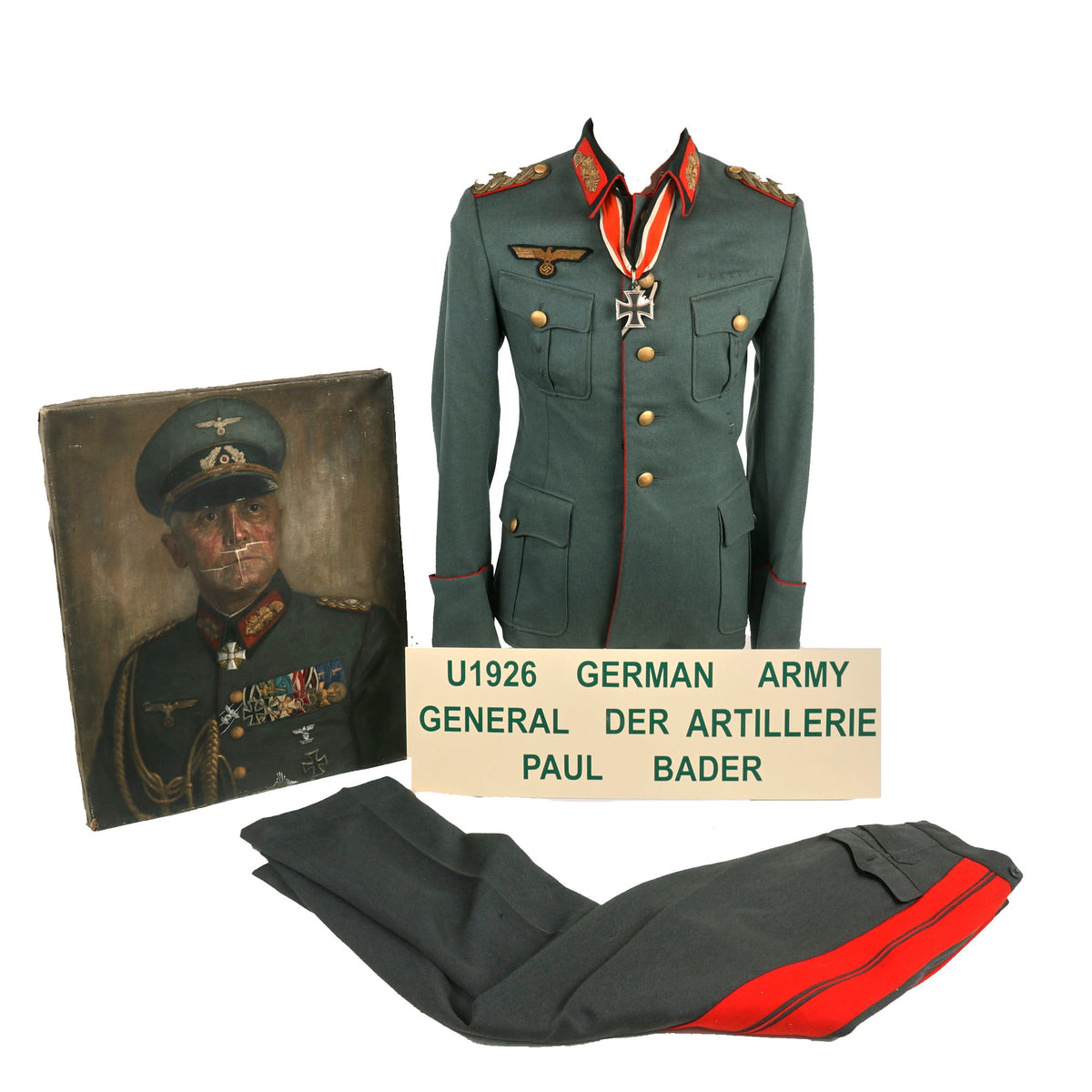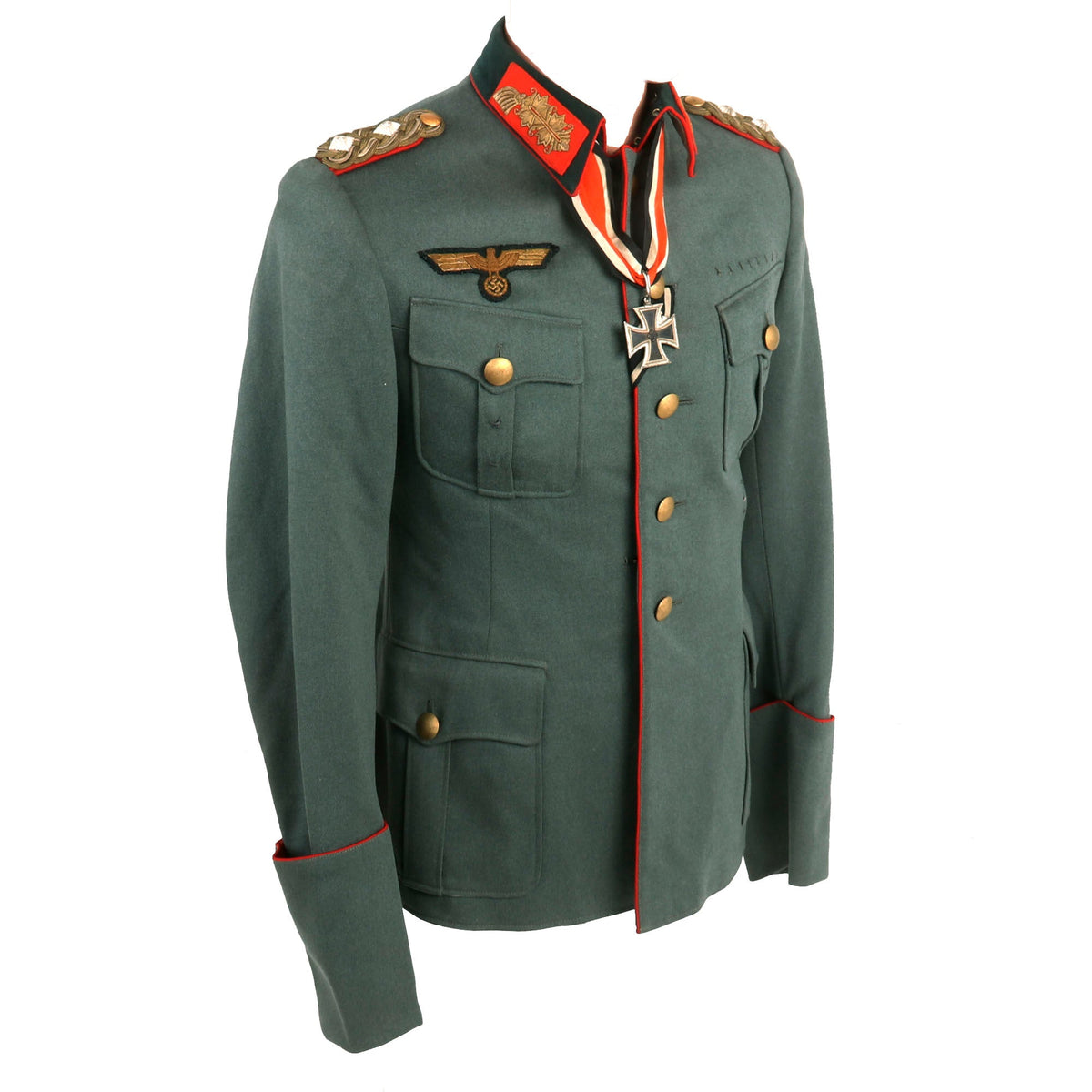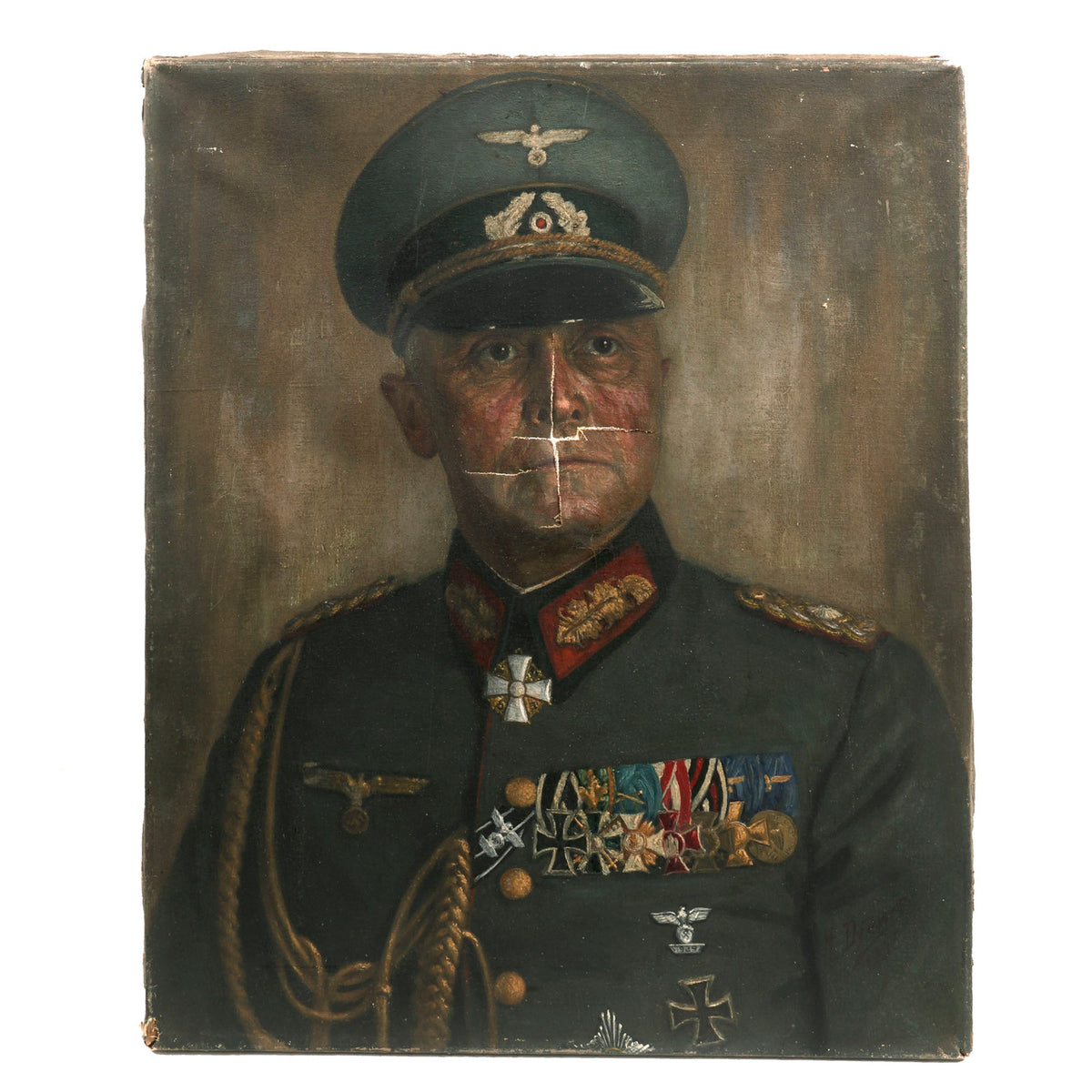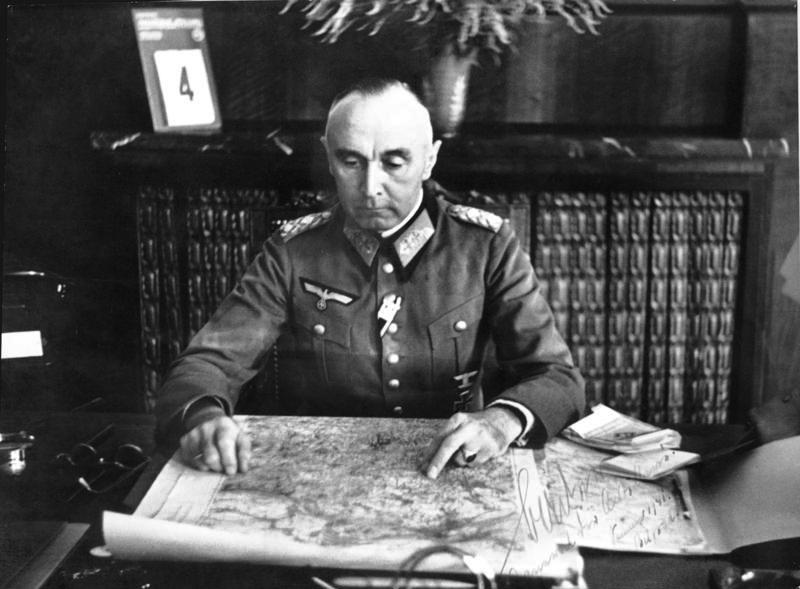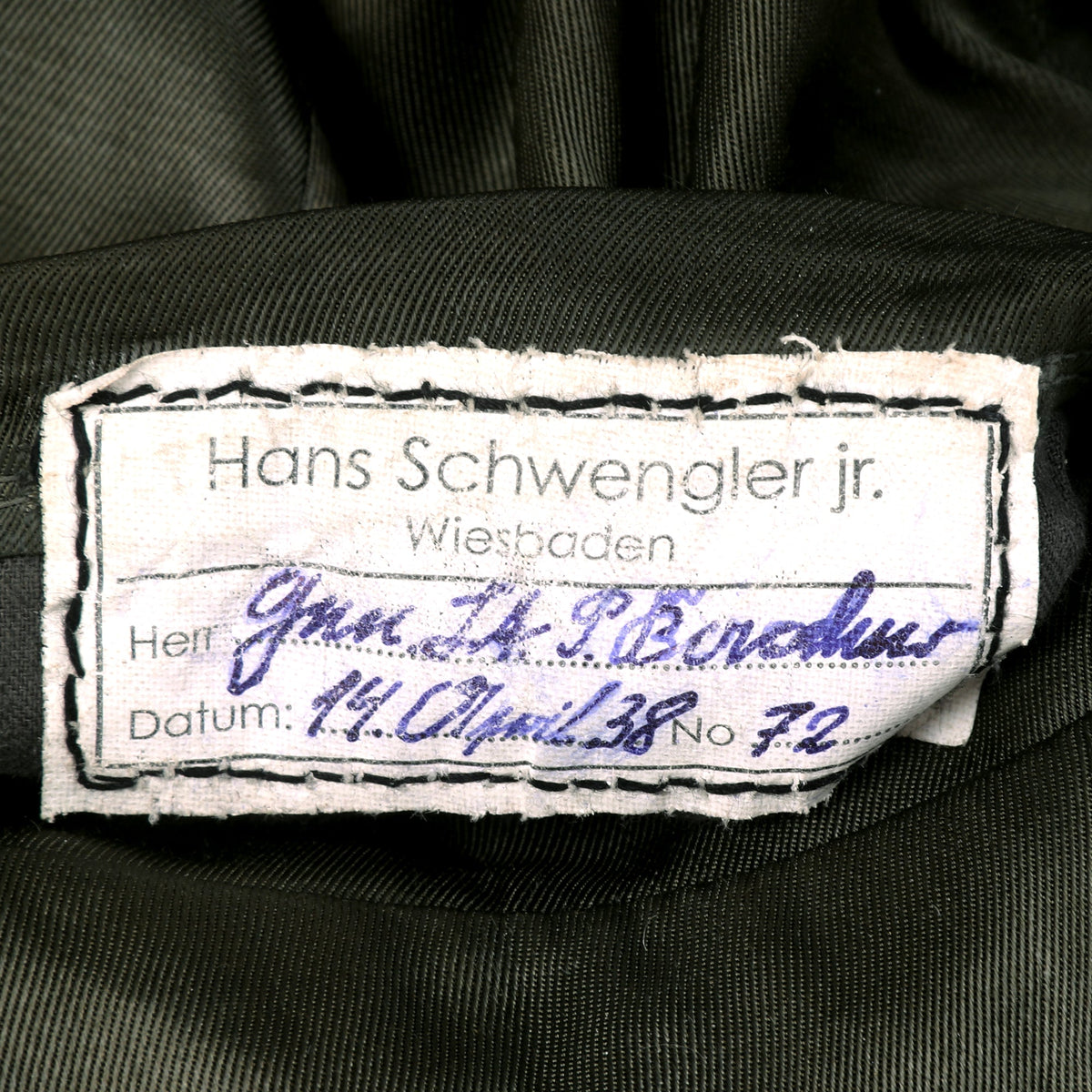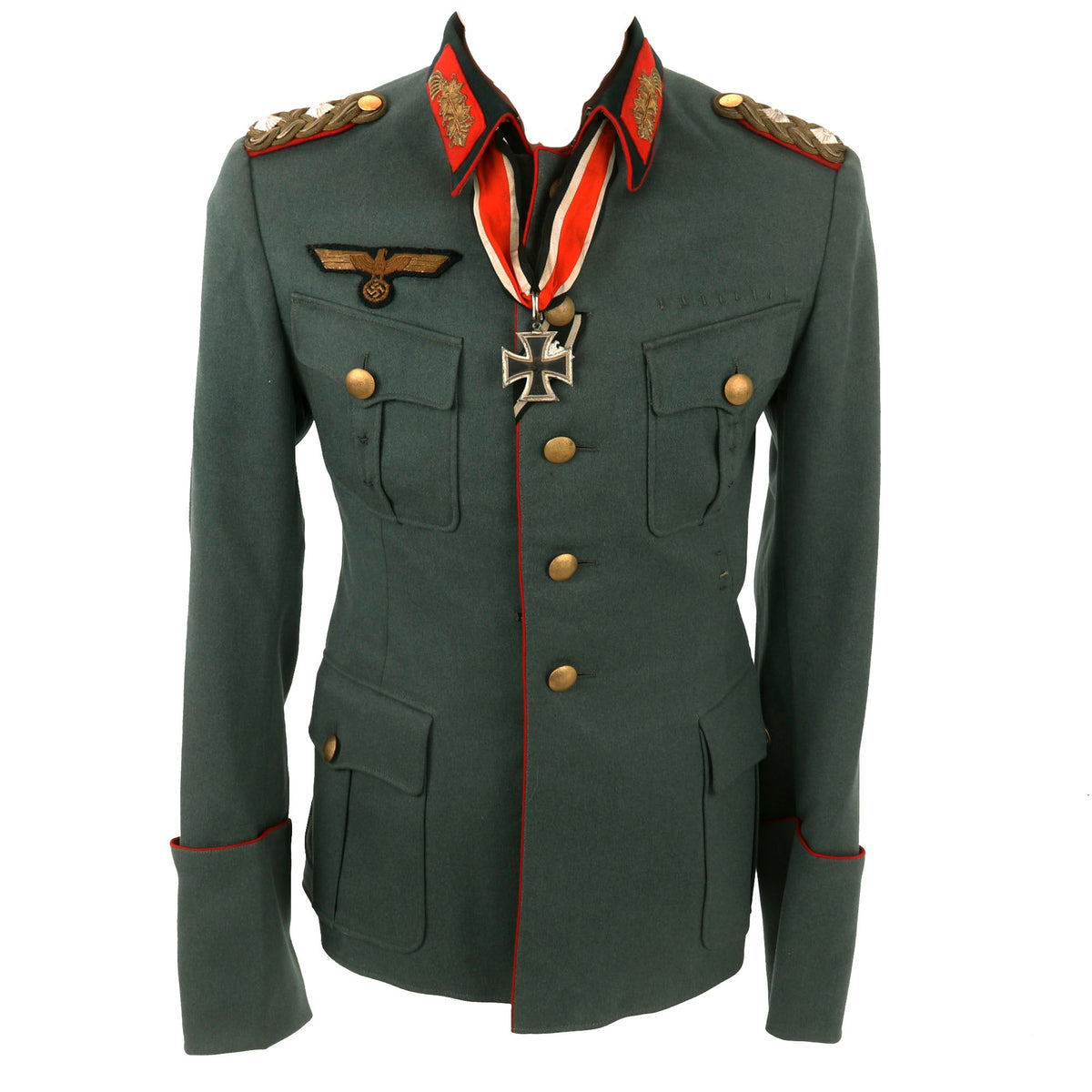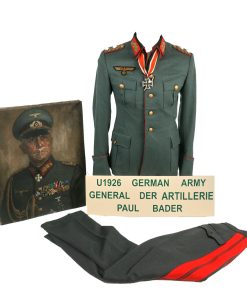Original German WWII Commander General der Artillerie Paul Bader – 2nd Motorized Infantry Div. & Serbian Territory Uniform & Portrait Set – Formerly Part of the A.A.F. Tank Museum Original Items
$ 11.995,00 $ 2.998,75
Original Items: One-of-a-kind set. Paul Bader (20 July 1883 – 28 February 1971) was a German Infanterie & Artillerie General in the Heer Army during World War II, who commanded the 2nd Motorized Infantry Division from 1 April 1937 to 1 October 1940. During this time it took part in the Invasion of Poland and the Invasion of France, where the division was quite successful, forming part of the XIV Corps within Panzer Group “Kleist” of Gerd von Rundstedt’s Army Group A. The division was then recalled to Germany, to be outfit as the 12th Panzer Division. At this time Bader was transferred to the 3rd Infantry Division, and later was made the commander of the Höheres Kommando z.b.V. LXV (Higher Command for Special Duties LXV).
In this capacity Bader commanded the occupying forces in Yugoslavia, 3 in Serbia and 1 in Croatia. This position eventually evolved into Bader becoming the Plenipotentiary General in Serbia on 6 December 1941, then in February 1942 was re-titled the Commanding General and Military Commander in Serbia. In this position he was in charge of anti-partisan activities in the occupied territories. Later he would be made commander of the XXI Mountain Corps in August 1943, but then was placed on reserve in October 1943 before retiring in March 1944 after a 41 year career.
Originally a Generalmajor (Brigadier General), he was promoted to Generalleutnant (Major General) in 1938 while commanding the 2nd Mot. Inf. Div., and then later to General der Artillerie (Lieutenant General) in July 1941 when assuming command of operations in Yugoslavia. He was the recipient of many prestigious awards during his career.
This wonderful German WWII Named Uniform Set came to us from the American Armoured Foundation, Inc. Tank and Ordnance Memorial Museum. The AAF Tank Museum was a living memorial dedicated to the Tank and Cavalry soldiers of the world. Before 1981 some of the artifacts that make up the AAF Tank Museum was a private collection belonging to Mr. William Gasser. Mr. Gasser felt that his collection would be beneficial in educating present and future generations to the sacrifices made and the technologies gained during war. Therefore, in 1981 the AAF Tank Museum was established as a non-profit charitable organization, and Mr. Gasser’s donated his private collection to the Tank Museum. Mr. Gasser is still active as Volunteer Director and Curator of the Tank Museum and his knowledge of military history has been a great asset to the museum. Unfortunately after 20 years of operation it had to close its doors, which is when this set was acquired.
Born 20 July 1883, Paul Bader joined the Prussian Army in 1903 at the age of 20, and became an officer candidate. He attended the war school, and after some time as an NCO / Officer Aspirant he was commissioned as a Leutnant in 1906. He would be transferred to the 80th Field Artillery Regiment in 1912, and subsequently promoted to Oberleutnant and appointed adjutant to the commander of the regiment. He took part in WWI, and by the end of the war had been promoted to Hauptmann (captain), after taking part in many legendary battles. He received numerous awards for his service during “The Great War”.
He would later continue his military service as a member of the Reichswehr under the Weimar republic. He was a career soldier, and continued his service after the NSDAP takeover of Germany. He was well-decorated, and the following is a list of awards we have been able to locate, along with the dates they were bestowed, if available:
● Iron Cross (1914)
– 2nd Class (27 March 1915)
– 1st Class (25 September 1917)
● Knight’s Cross of the Friedrich Order, 1st class with swords (Kingdom of Württemberg)
● Knight’s Cross Second Class of the Order of the Zähringer Lion with swords and oak leaves (Baden)
● Cross of Honor for Frontline Fighters
● Iron Cross (1939)
– 2nd Class (spange)
– 1st Class (spange)
● German Cross in Gold on 29 January 1943 as General der Artillerie and commander in Serbia
It should also be noted that due to his long service he would have qualified for the Wehrmacht Long Service awards, and other awards not listed. Many of these can be seen on the portrait of Bader included in this set. The uniform tunic itself unfortunately has had the medal bar and awards removed at some point in the past. It is also fitted with a “Field Upgraded” Knight’s Cross (an EKII with Ribbon) to take place of the Friedrich order Knight’s Cross.
The lovely M36 uniform tunic in this set was made for Bader in April of 1938, when he was a Generalleutnant and commander of the 2nd. Motorized Infantry Division. This was prior to the invasion of Poland and France, when the build up to the war was fully underway. It is a lovely bespoke example, and the outside of the inner left chest pocket still has a fully intact tailor label, which reads:
UNIFORMEN
Hans Schwengler jr.
WIESBADEN
The uniform also still has a clear matching maker label inside the left inner pocket, which gives the details of the order:
Hans Schwengler jr.
WIESBADEN
——————-
Herr Gen. d.A. P. Bader
Datum: 14. April. 38 No. 72
Later when Bader was promoted to General der Artillerie during 1941, all that was needed was to have the second pip added to the shoulderboards, though it is possible that they were entirely replaced as well. The name tag on the inside may have been replaced and/or relabeled by the tailor when this was done as well.
The tunic is really a great example of a private purchased Wehrmacht Heer Generäle Dienstbluse (General Officer Service Tunic). It is constructed from a fine quality field-gray “whipcord” wool woven exterior, with a silk-rayon blended interior lining. The sleeves are lined with the usual blue / gray striped rayon. The collar is constructed of flaschengrün (dark bottle-green) wool, and is adorned by a set of General grade collar tabs, known as alt-Larisch or Arabesque style, which were used for all General ranks below Feldmarschall. These have the correct red backgrounds with gold bullion embroidery. and the collar edge, front closure, and the cuffs are piped with red as well.
The tunic conforms well to the M36 pattern, having 4 pleated pockets on the front with scalloped flaps. The front closure features five of the same buttons on the right breast flap meeting an equal number of reinforced buttonholes on the left flap. All of the pebbled buttons are the correct gold color for a General officer, and all look to be marked EXTRA FEIN on the back. The buttons are all sewn directly to the fabric, as is usually seen on private purchased examples.
Each shoulder is decorated with the sew-on style General der Artillerie rank shoulder boards. They are both constructed out of a row of interwoven silver and gold bullion strands in the typical Russian braid style in an interlocking weave pattern ending at a pebbled gilt metal (magnetic) button. There are two rank pips installed, correct for a General der Artillerie and other specialized General ranks equivalent to a U.S. Army Lt. General. Of note is that they are identical in material and size, so the shoulder boards may have been replaced completely when Bader was promoted.
On the right breast is a fine quality gold bullion eagle, constructed of rolled, twisted, and flat hand embroidered gilt stitching with gold cotton retaining threads, placed onto a dark bottle green wool backing. It is neatly stitched to the outer layer of fabric, and still has a great deep gold color. There is additionally an Iron Cross 1914 Ribbon sewn into the second buttonhole from the top, complete with an Iron Cross 1939 Spange (clasp). Above the left breast pocket are numerous thread loops to hold a long ribbon bar, and there are thread loops on and under the pocket for additional awards. There are even some thread loops on the right side of the tunic as well, several on the pocket, and one next to the front closure.
Along with the tunic there is a lovely pair of General’s breeches / jodhpurs in the correct stone gray (steingrau) color, with red stripes on the side, which comes with the correct suspenders. They are in very good shape, and definitely period correct, though they do not have any markings on the inside.
Along with the uniform are some great additional items that really flesh out this fantastic set, and add lots of wonderful research and display potential. These include:
● A fantastic 18″ x 21 ¾” oil on canvas portrait of Paul Bader, which looks to be from the later war period. Per his shoulder rank insignia he is a Generalleutnant, but it shows the German Cross award he received when he was a General der Artillerie. The portrait shows what looks to be the same uniform in this set, however it is outfit with all of the original awards as well as his officer’s aguillette cords. It is in very good condition, though there are several tears across his face area.
● The original painted metal display placard used when the uniform was owned and displayed by the A.A.F. Tank Museum.
● The original information / inventory listing from the A.A.F. Tank Museum, which gives a very detailed history of Bader’s military progression during the interwar years and during the war.
We were also able to find a very nice period photograph of Bader on the internet, which is shown for illustrative purposes only and is not included.
We very seldom get uniform sets with such great provenance and research potential. This could become the centerpiece of your WWII collection. Ready to research and display!
Approximate Measurements:
Collar to shoulder: 10″
Shoulder to sleeve: 26.7”
Shoulder to shoulder: 14.5”
Chest width: 18″
Waist width: 16″
Hip width: 17.5″
Front length: 28.5″
Pant:
Waist: 17.5″
Inseam: 31.5″
More Military Service Information on Paul Bader:
Paul Bader (20 July 1883 – 28 February 1971) was a General der Artillerie (lieutenant general) of the Wehrmacht during World War II who commanded the 2nd Motorized Infantry Division in the invasions of Poland and France then served as a corps commander and as Military Commander in Serbia. During his time in occupied Yugoslavia troops under his command engaged in several major anti-Partisan operations, within both the Territory of the Military Commander in Serbia and in the Independent State of Croatia.
Early service and World War I
Bader joined the Prussian Army in 1903 at the age of 20, as an Einjährig-Freiwilliger (volunteer reserve officer) and was subsequently accepted as a Fahnenjunker (officer candidate) and attended the Kriegsschule (War School). While awaiting his commission he was appointed as a Fähnrich (junior non-commissioned officer) in the 66th Field Artillery Regiment of the 39th Division. He was commissioned into the regiment on 21 May 1906 as a Leutnant (lieutenant). In 1912, he was transferred to the 80th Field Artillery Regiment.
On 20 November 1913, he was promoted to Oberleutnant (first lieutenant) and was appointed as the adjutant to the commander of the 80th Field Artillery Regiment. The regiment was deployed to Kolmar in Alsace-Lorraine and at the outbreak of World War I they saw action along the eastern border of Germany known as the Battle of the Frontiers. The 39th Division then participated in the Race to the Sea between September and November 1914, which brought the 39th Division to a position along the Yser River in Flanders, Belgium. While on this part of the front, the 39th Division fought in the Battle of the Yser. In April 1915, Bader was promoted to Hauptmann (captain) and was appointed as the adjutant to the commander of the 39th Field Artillery Brigade. After deploying to northeastern France in early 1916 the division reinforced the German attack at Verdun. During the remainder of the war, Bader remained with the 39th Division, which fought in the Battle of the Somme, the Second Battle of the Aisne, the Battle of Passchendaele, and the German spring offensive of 1918.
Interwar years
During the interwar years Bader remained active in the German artillery forces of the Reichswehr, and was promoted to major (major) in 1925. Between 1919 and 1928, he commanded various artillery batteries. As part of the expansion of the German military starting in 1933, Bader was promoted to oberst (colonel) and commanded several artillery regiments including the 5th Artillery Regiment and the Artillery Regiment “Ludwigsburg”. He was promoted to generalmajor (brigadier) in 1935, and took command of the 2nd Infantry Division on 1 April 1937. The division was subsequently renamed the 2nd Motorised Infantry Division and Bader was promoted to generalleutnant (major general) in 1938.
World War II
Poland and France
When war broke out in 1939, Bader commanded the 2nd Motorized Infantry Division during the invasion of Poland, where it formed part of Heinz Guderian’s XIX Corps within the 4th Army of Army Group North. In September 1939, Army Group North drove east from Western Pomerania to cut the Polish Corridor to East Prussia, then fulfilled a support role during the advance towards Brest-Litovsk.
Following the successful end of the Polish campaign, Bader’s division was transferred to the west to prepare for the invasion of France. The division formed part of the XIV Corps within Panzer Group “Kleist” of Gerd von Rundstedt’s Army Group A. In May and June 1940, Army Group A thrust through the Ardennes, across the Meuse and towards the Channel Ports of Dunkirk and Calais then south to outflank the Maginot Line. Bader commanded the 2nd Motorised Division until October 1940 when it returned to Germany and was re-organised as the 12th Panzer Division. In October 1940, Bader was appointed as the commander of the 3rd Motorised Infantry Division which had also returned to Germany to be re-fitted as a fully motorised division in preparation for Operation Barbarossa.
Yugoslavia
In May 1941, just before the division was committed to the attack on the Soviet Union, Bader was replaced as commander of the 3rd Motorised Infantry Division and on 1 July 1941 he was promoted to General der Artillerie (lieutenant general) and was appointed as the commander of the Higher Command LXV, which was essentially a corps headquarters commanding four garrison divisions stationed in occupied Yugoslavia, three in the Territory of the Military Commander in Serbia and one in the Independent State of Croatia. After assisting with the crushing of the uprising in Serbia, Bader became the Plenipotentiary General in Serbia on 6 December 1941, then in February 1942 was re-titled the Commanding General and Military Commander in Serbia.
Bader ordered on January 3 1942 that admitting Jews into their homes and hiding their things and value papers is punishable by death. On February 8 he ordered that saboteurs should be executed, hanged on the spot if possible to terrify the population and that only in special cases hostages can be taken. On October 10 Bader decided that disappeared German soldiers should be counted as dead for retributions. Massacre in Kriva Reka during Operation Kopaonik committed by SS Prinz Eugen became huge news in Serbia and people started talking about terror of SS Prinz Eugen. Bader had to warn the unit not to order similar actions without a reason, because it could cause negative consequences. He also thought that unit was “too used to Balkan methods”. On insistence of August Meyszner, Bader ordered additional measures against resistance on October 5 accord to which family members of uprisers could either be fined, sent to Germany as forced labor or executed in reprisals on August 6 1943.
On 26 August 1943 he was transferred to command the newly created XXI Mountain Corps in Albania, however he was only in this position for a few months before he was placed on the Führerreserve list in October 1943 then retired on 31 March 1944, having served in the German Army for 41 years.
More on German Uniform Tunics
Terms such as M40 and M43 were never designated by the Wehrmacht, but are names given to the different versions of the Model 1936 field tunic by modern collectors, to discern between variations, as the M36 was steadily simplified and tweaked due to production time problems and combat experience.
Field Tunic (Feldbluse) Model 1936
When the NSDAP came to power in early 1933 the Reichswehr, the armed forces of the Weimar Republic, were near the end of a two-year project to redesign the Army Feldbluse (field-blouse). Beginning in that year the new tunic was issued to the Reichsheer and then the rapidly growing Wehrmacht Heer, although minor design changes continued to be made until the appearance of the standardized Heeres Dienstanzug Modell 1936. The M36 tunic still retained the traditional Imperial and Reichswehr uniform color of grey-green “field gray” (feldgrau) wool, but incorporated four front patch pockets with scalloped flaps and pleats (on Reichswehr tunics the lower pockets were internal and angled). The front was closed with five buttons rather than the previous eight, and the collar and shoulder straps were of a dark bottle-green instead of the Reichswehr grey. Compared to the Weimar-era uniforms the skirt of the feldbluse was shorter and the tailoring was more form-fitting due to Germany’s adoption of mechanized warfare: soldiers now spent much time in the confined space of a vehicle and a shorter jacket was less likely to pick up dirt from the seats. It also included an internal suspension system, whereby a soldier could hang an equipment belt on a series of hooks outside of the tunic. These hooks were connected to two straps inside the lining, which spread the weight of equipment without having to use external equipment suspenders. The M36 was produced and issued until the very end of the war, though successive patterns became predominant.
Fast Shipping with Professional Packaging
Thanks to our longstanding association with UPS FedEx DHL, and other major international carriers, we are able to provide a range of shipping options. Our warehouse staff is expertly trained and will wrap your products according to our exact and precise specifications. Prior to shipping, your goods will be thoroughly examined and securely secured. We ship to thousands clients each day across multiple countries. This shows how we're dedicated to be the largest retailer on the internet. Warehouses and distribution centres can be located throughout Europe as well as the USA.
Note: Orders with more than one item will be assigned a processing date depending on the item.
Before shipping before shipping, we'll conduct a thorough inspection of the items you have ordered. Today, the majority of orders will be delivered within 48 hours. The delivery time will be between 3-7 days.
Returns
The stock is dynamic and we cannot completely manage it because multiple stakeholders are involved, including our factory and warehouse. So the actual stock may alter at any time. It's possible that you may not receive your order once the order has been made.
Our policy is valid for a period of 30 days. If you don't receive the product within 30 days, we are not able to issue a refund or an exchange.
You can only return an item if it is unused and in the same state as the day you received it. You must have the item in its original packaging.
Related products
Uncategorized
Uncategorized
Uncategorized
Uncategorized
Uncategorized
Uncategorized
Uncategorized
Uncategorized
Uncategorized
Uncategorized
Uncategorized
Uncategorized
Uncategorized
Uncategorized
Uncategorized
Uncategorized
Uncategorized
Armoured Fighting Vehicles of the World: AFVs of World War One (Hardcover Book) New Made Items
Uncategorized
Uncategorized
Uncategorized
Band of Brothers ORIGINAL GERMAN WWII Le. F.H. 18 10.5cm ARTILLERY PIECE Original Items
